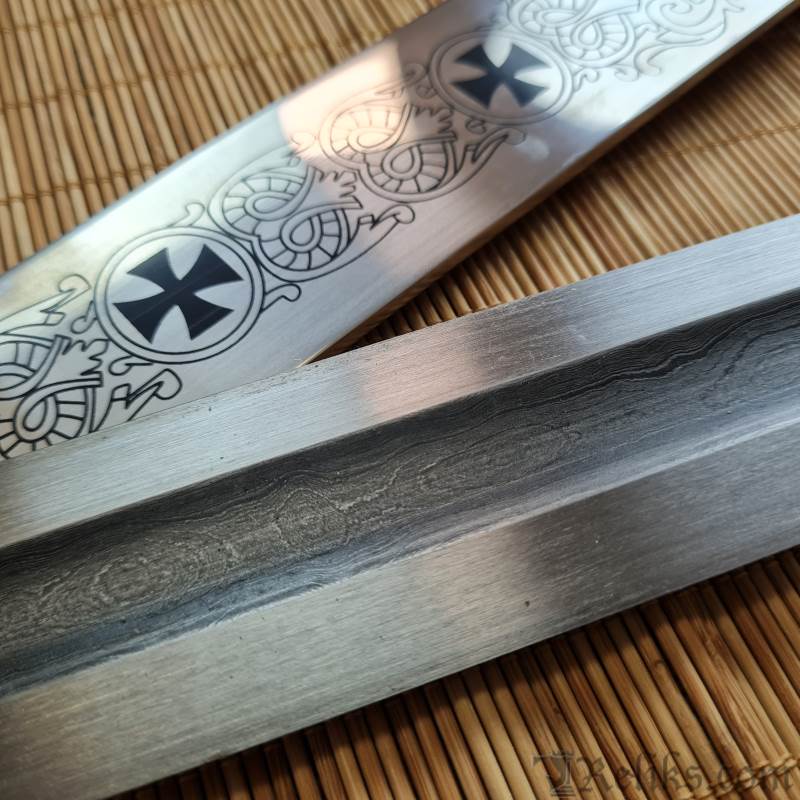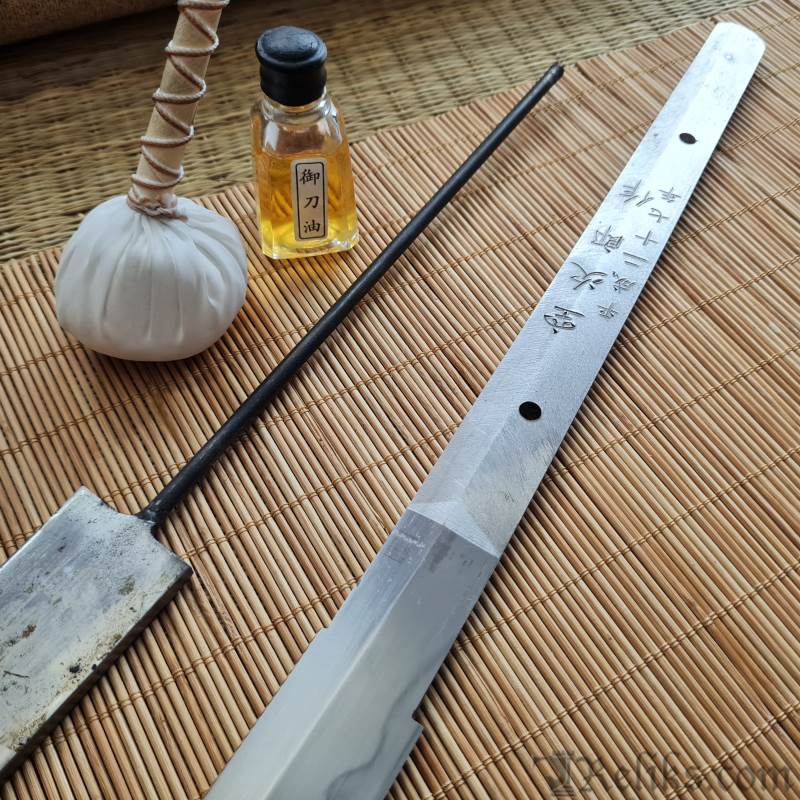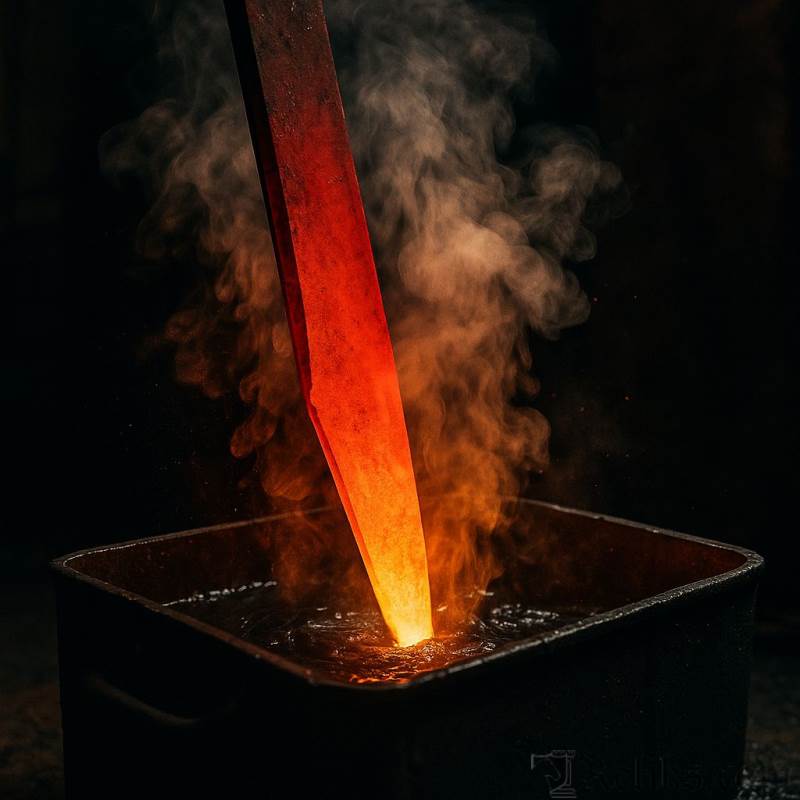The Decorative Sword vs. The Functional Sword
In this article, we’ll explore the key differences between functional swords and decorative swords. These two sword categories serve very different purposes. This isn’t a contest between the two. Both are beautifully made and valuable for their intended use. Our goal is simply to explain how we determine which swords are safe for cutting and martial arts practice, and which are best displayed on your wall.
Is It All in the Steel?

stainless blade (top), hand forged high carbon damascus steel blade (bottom)
The most important difference between a functional sword and a decorative sword starts with the steel.
Decorative swords are usually made with stainless steel blades. Stainless steel is ideal for display because it resists corrosion and requires very little maintenance. However, it’s too hard and brittle for real use. Long stainless blades can fracture or bend under the stress of cutting or reenactment. This is why stainless steel is best left to decoration.
Functional swords, on the other hand, are forged from high carbon steels designed to balance hardness and flexibility. You may have heard of Damascus steel or folded steel, legendary techniques once used to strengthen impure iron sands. Today, modern functional swords are made from pure, high-quality carbon steels that no longer require folding for strength. Swordsmiths still use folding and Damascus patterns as a nod to tradition and aesthetics, but a properly forged and tempered carbon steel blade is often stronger.
Some decorative swords are made from carbon steel as well, but instead of being forged, they are machine-cut or pressed into shape. Forging a blade is the process of hammering and aligning the carbon structure of the steel and is what gives a true functional sword its resilience.
What About the Tang?

stick tang (left), 3/4 or full tang (right)
The tang is the hidden part of the blade that runs through the handle and connects the hilt to the blade. You can’t usually see it unless the sword is disassembled.
For decorative swords, the tang only needs to hold the handle and fittings together. Manufacturers often use a “rat-tail” tang (a thin rod welded to the blade’s base) or a “stick” tang. These are perfectly fine for display but unsafe for use, as they can snap or loosen during impact, often sending the blade flying across the room or back towards the wielder.
Functional swords use far stronger designs. The two most common are the full tang and the 3/4 tang:
- Full Tang:
Common in European swords, the blade’s steel extends the entire length of the handle and is either peened or threaded at the end to secure the pommel.
- 3/4 Tang:
Found in most Japanese swords (katanas), this tang runs nearly the full handle length and is secured with bamboo mekugi pegs. Despite stopping short of the pommel, the 3/4 tang provides exceptional strength and torque resistance.
Both designs are capable of withstanding the stresses of cutting practice, demonstrations, or martial arts training.
Tempering, Quenching, and Flex

Queching the Steel (dramatization)
This is where the functional sword truly sets itself apart.
Decorative swords are not heat-treated because they don’t need to perform under stress. Functional swords, however, go through a precise process of heating, quenching, and tempering to achieve the ideal balance of hardness and flexibility.
A common misconception is that functional swords are heavy, rigid slabs of steel. In reality, most historically accurate swords weigh between 2–3 lbs, with even the largest greatswords rarely exceeding 4 lbs. This balance of weight and flexibility is only possible through proper tempering.
Japanese swordsmiths take this even further through differential tempering. They coat the spine of the blade with clay before quenching, which cools the spine slower than the edge. This results in a hard, sharp edge that holds its sharpness and a softer spine that absorbs shock and flexes without breaking. The process naturally creates the iconic curve and visible hamon line on the blade, a mark of true craftsmanship.
In contrast, decorative swords often display an acid-etched hamon to imitate the look of a real one, purely for appearance.
Choosing Between Functional and Decorative Swords
Both types of swords have their place.
Decorative swords are perfect for display, cosplay, or interior décor, while functional swords are made for cutting practice, martial arts, and historical reenactment. When choosing, remember that:
- “Sharpened”
doesn’t always mean functional.
- “High carbon steel”
doesn’t guarantee it’s battle-ready.
- “Full tang”
doesn’t automatically make it safe to use.
A true functional sword is the result of forging, tempering, and proper construction and not just the materials listed.
To make your search easier, we’ve divided our collection into two clear categories on our website:
Functional Swords
and Decorative Swords
.
Whether you’re a collector, martial artist, or history enthusiast, you’ll find the right sword for your purpose.